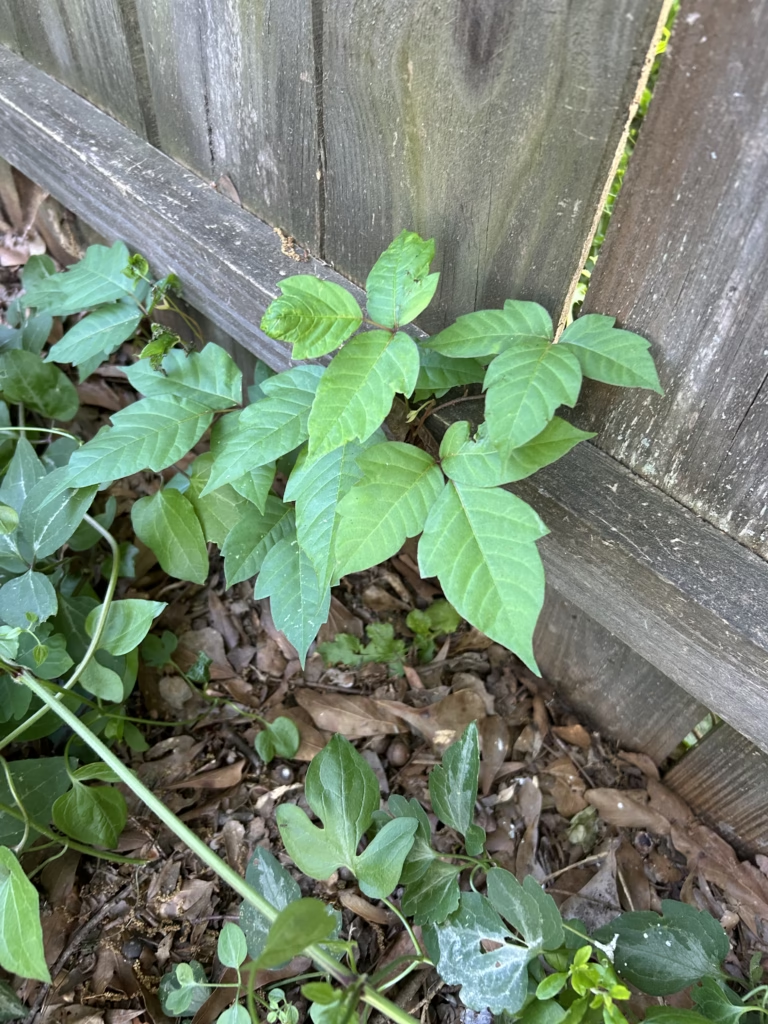Last spring, I made a classic beginner’s mistake: I tore out an entire patch of mock strawberry from my backyard, convinced it was poison ivy. Gloves on, sleeves rolled down, I yanked every last stem (or so I thought) only to learn later that I’d removed a harmless groundcover. It turns out, I’m not alone in this. Many plants, especially in regions like Georgia, bear a passing resemblance to poison ivy.
The Potentilla indica, or wild strawberry/mock strawberry, is just one of those backyard weeds often mistaken for poison ivy. There are so many native vines and shrubs in Georgia that share similar characteristics—like Virginia creeper, boxelder, clematis, and even some types of ivy when they are young.
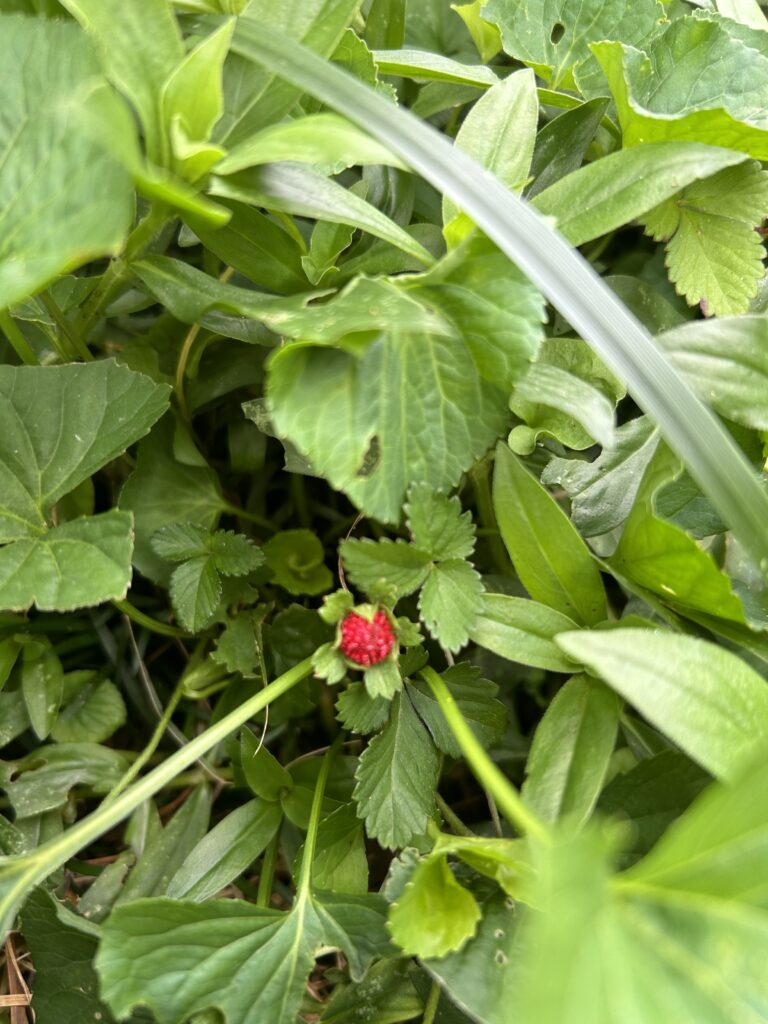
During this second year of nurturing the wildscape in my backyard, I’m learning to identify everything that’s growing and whether or not it is native, naturalized, invasive, edible, or medicinal. My yard is full of three-leaved shrubs and vines that resemble poison ivy, and I don’t want to make the same mistake twice. Being able to correctly identify poisonous plants helps ensure you only remove those that are truly hazardous, while leaving beneficial or simply harmless plants alone.
Toxicodendron radicans, or poison ivy, is a native plant found throughout most of the United States—everywhere except California, Alaska, and Hawaii. It’s highly adaptable, thriving in a variety of climates and conditions, and prefers disturbed ground. You’ll often find it along forest trails, fences, or climbing up trees, camouflaged among more benign vegetation.
Toxicodendron radicans, or poison ivy, is a native plant that can be found throughout the United States, except in California, Alaska, and Hawaii. Poison ivy can thrive in a variety of climates and conditions and actually prefers “disturbed ground” disguising itself as a groundcover. You will often find it on forest trails, fences, or climbing up trees.
How to Avoid Poison Ivy
The easiest way to avoid poison ivy is to avoid poison ivy. In other words, approach wooded areas with caution and don’t go grabbing or stomping over plants. If your contact is intentional, wear pants, socks, closed-toed shoes, long sleeves, and gloves.
Poison ivy does not hurt what it does not touch, and humans alone react to the urushiol that causes allergic dermatitis. Birds, deer, and other wildlife consume the leaves and berries, and it provides beautiful groundcover for areas you needn’t trod across, sheltering a variety of creatures. So, if you don’t have small children to protect, or pets that may transmit the oil that causes the allergic reaction on their fur, you can simply avoid it, if you wish and move on with your life.
But, perhaps you do have young children (like me), how can you avoid removing beneficial and harmless plants in your quest to eradicate poison ivy?
How to Identify Poison Ivy
The general advice when it comes to poison ivy is “leaves of three, let them be.” But there are other plants can have leaves of three, such as my mock strawberries, so this isn’t entirely helpful.
Poison ivy leaves can have smooth, serrated, or lobed edges, which doesn’t help in identification and it doesn’t help that poison ivy can appear as a climbing vine, or as a bushy shrub that can grow as tall as six feet. The vines can reach up to 150 feet.
Luckily, there are other clever cautions to help you identify poison ivy, like “hairy vine, no friend of mine,” or “berries white, danger in sight,” or my personal favorites, “hairy rope, don’t be a dope,” and “side leaves like mittens will itch like the dickens!”
All of these folk wisdoms contain a bit of truth and taken together can give you a generally good idea of whether or not the plant in question is poison ivy.
Leaves of Three, Let Them Be
Poison ivy grows as a compound leaflet with three leaves, a characteristic that distinguishes it from other native vines, such as Virginia creeper, which has five leaflets. However, one simple way to distinguish poison ivy from boxelder or Virginia Creeper is to look at how the leaves grow. Poison ivy leaves grow in an alternating fashion, rather than directly across from one another.
Longer Middle Stem, Stay Away From Them
Poison ivy has a middle leaflet that is longer than the outer two leaflets. This isn’t always a giveaway, as this is also true of many rubus varieties.
Side Leaves Like Mittens Will Itch Like the Dickens
Not only is this the cutest one, it is usually a good indicator that you are looking at poison ivy. Some poison ivy leaves have a small “notch” on the sides of the two outer leaflets that look like thumbs, making the leaf look like a mitten.
Red Leaves in the Spring Are a Dangerous Thing
Some varieties of poison ivy can have red leaves when they first appear in the spring and then turn green in the summer. When green, the leaves can appear glossy or dull. Fall may bring another color change to red or orange.
Hairy Vine, No Friend of Mine
One of the most distinctive features of poison ivy—especially when it’s climbing—is its hairy-looking aerial rootlets. These roots help it cling to tree trunks, fences, or walls and give it a “fuzzy” appearance. This trait is especially helpful in distinguishing it from similar-looking vines, which tend to have smoother stems. If you see a vine with lots of tiny, reddish-brown rootlets clinging to bark or masonry, it’s best to steer clear.
However, note that poison ivy does NOT have thorns. Thorns indicate you are likely looking at a variety of rubus.
Berries White, Danger in Sight
Poison ivy produces small, white to grayish berries in late summer to fall. These berries are an important food source for many birds, but they are toxic to humans. If you notice clusters of white berries on a climbing or sprawling plant with three-leaflet arrangements, consider it a red flag.
Common Poison Ivy Look-Alikes
Poison ivy’s deceptive appearance has led to the misidentification of countless native and naturalized plants—many of which are harmless, beneficial, or even edible. Here are some of the most common culprits in Georgia and other temperate regions:
Mock Strawberry (Potentilla indica)
Often mistaken for poison ivy due to its trifoliate leaf structure, this low-growing groundcover has bright yellow flowers (unlike the white flowers of true strawberries) and small, red, dry-textured fruits. Though not toxic, its bland berries and creeping growth habit make it more of a weed than a garden gem. It spreads through stolons and thrives in disturbed soils—just like poison ivy—but is easy to identify once flowering.
Virginia Creeper (Parthenocissus quinquefolia)
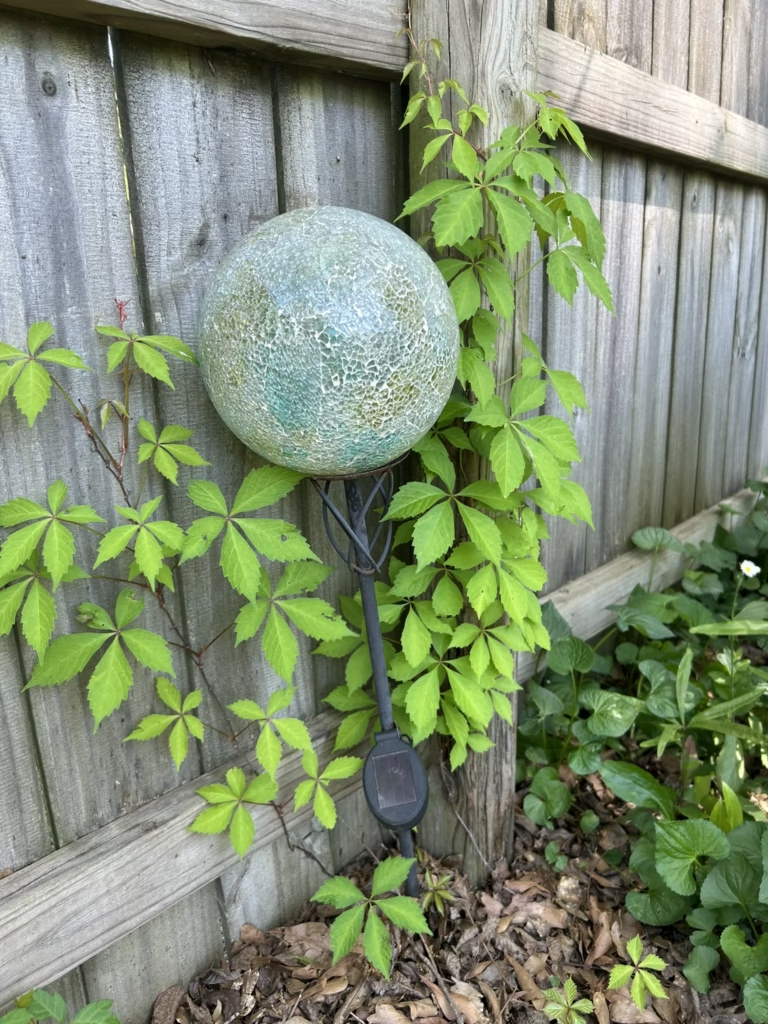
This vigorous native vine is frequently confused with poison ivy in its early stages, when leaves sometimes appear in threes. However, mature plants reliably have five leaflets per leaf, a key distinction. In fall, Virginia creeper turns a brilliant red and produces dark blue berries, not the white ones associated with poison ivy.
Boxelder (Acer negundo)
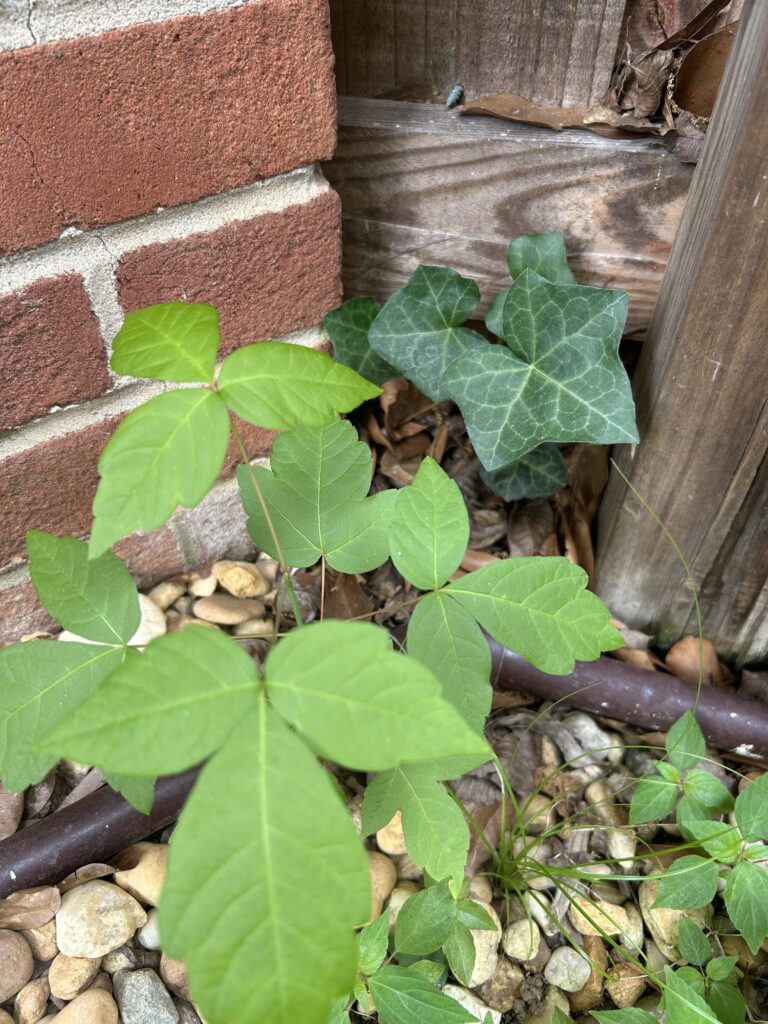
A young boxelder seedling can be tricky, with its compound leaves often forming in threes. However, unlike poison ivy, its leaves grow opposite each other on the stem. As it matures, it reveals its identity more clearly as a maple relative.
Clematis species
Some native clematis vines bear vaguely similar leaves and climbing habits. However, they lack the telltale hairy rootlets of poison ivy and usually have more elongated leaves. When in doubt, check for flower buds or trailing stems that aren’t self-clinging.
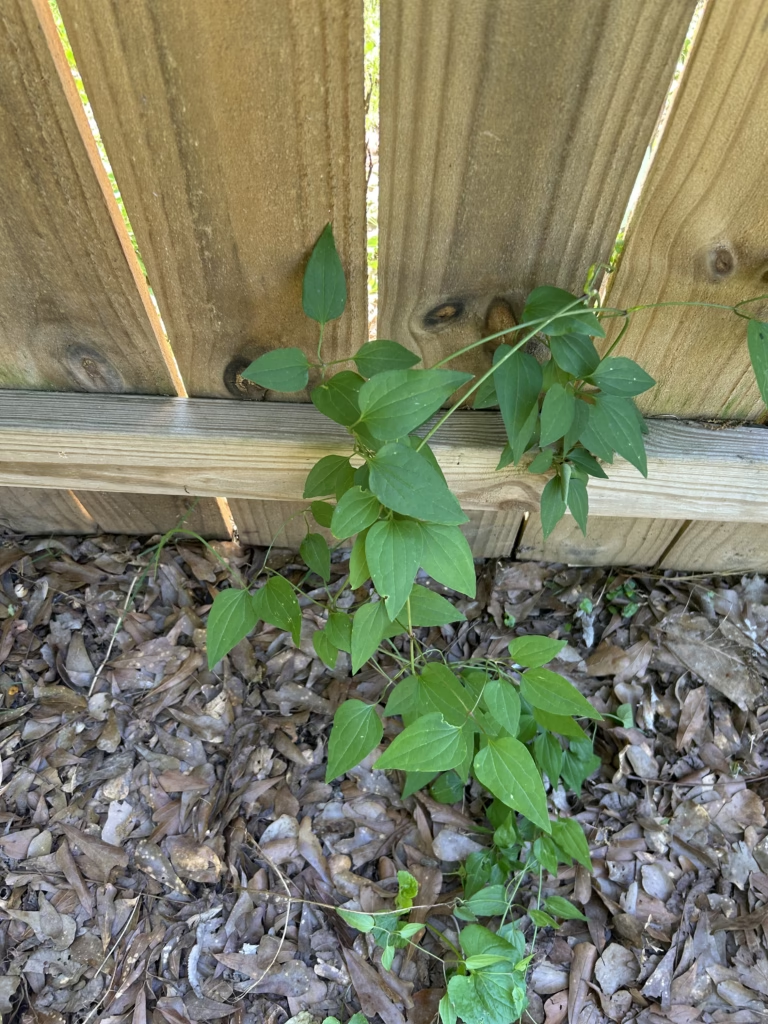
Young Ivy (Hedera spp.)
English ivy and its relatives are non-native, highly invasive, evergreen vines that can sometimes be confused with poison ivy when immature. Their leaves may have a similar gloss, but they typically grow in a more uniform pattern and lack the variable shape and hairy vines of poison ivy.
By learning to distinguish these common look-alikes, you can better protect yourself and also avoid removing plants that may have ecological or aesthetic value. In your effort to keep your yard safe, you’re also becoming a more attentive and ecologically mindful steward of your local landscape.
Blackberry and Raspberry (Rubus spp.)
These brambles have trifoliate leaves similar to poison ivy but can be identified by their thorny stems and textured leaves. Unlike poison ivy, Rubus plants produce edible fruits and have a more rigid, upright growth habit.
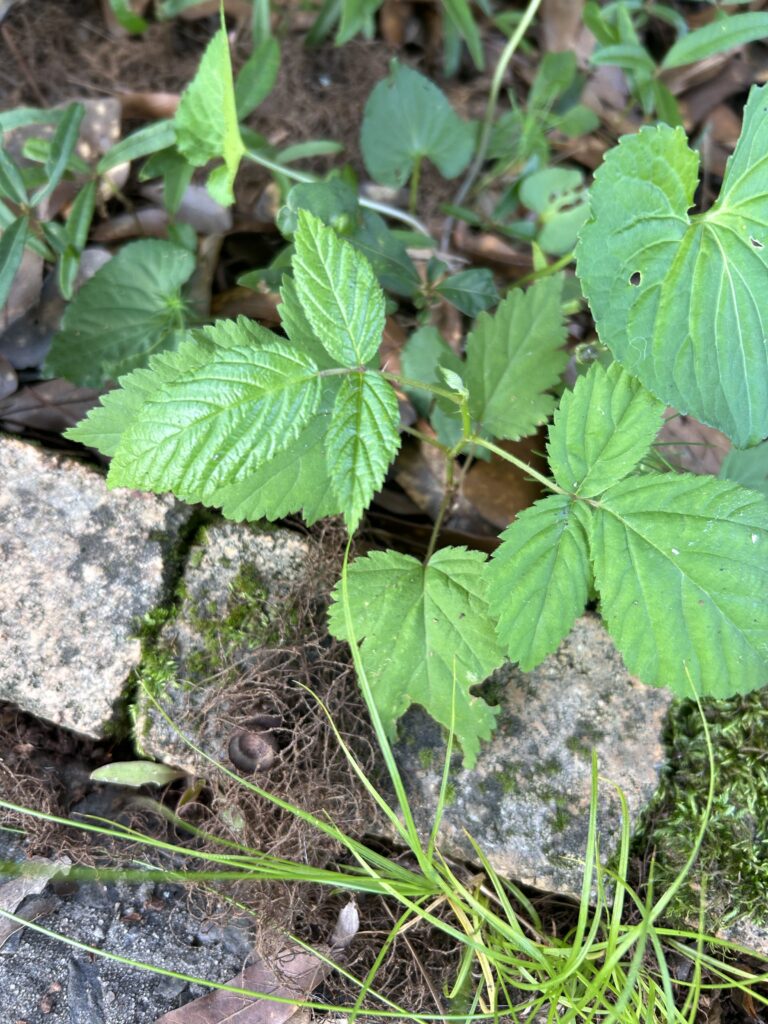
How to Identify Poison Oak
Poison oak (Toxicodendron diversilobum in the West, Toxicodendron pubescens in the East) closely resembles poison ivy and shares the same allergenic oil, urushiol. Its appearance varies by region but there are consistent traits to watch for:
- Leaf shape: Poison oak leaves typically grow in clusters of three (occasionally five or seven), and are lobed or scalloped—often resembling oak leaves, hence the name.
- Growth form: In the East, it tends to grow as a low shrub. In the West, it can appear as a climbing vine or a dense thicket.
- Color and texture: Leaves are green in spring and summer, turning red, orange, or yellow in fall. The surface may appear slightly fuzzy or dull.
Berries: Like poison ivy, poison oak produces clusters of small white or yellowish berries in late summer.
Despite the similarities, poison oak usually grows more upright than poison ivy and prefers drier, more open areas like woods and fields rather than moist, shaded locations.
How to Identify Poison Sumac
Poison sumac (Toxicodendron vernix) is less commonly encountered than poison ivy or poison oak, but it delivers the most potent reaction. It’s more likely to be found in swampy or boggy areas, particularly in the southeastern United States.
- Leaf structure: Unlike the familiar “leaves of three” warning, poison sumac has 7 to 13 leaflets arranged in pairs with a single terminal leaflet. The leaflets are elongated with smooth edges and taper to a point.
- Growth habit: It grows as a tall woody shrub or small tree, often reaching 10 to 20 feet in height.
- Bark and stems: Its stems are smooth and reddish, and unlike harmless sumac species, they don’t have fine hairs.
- Berries: Poison sumac produces drooping clusters of white or pale green berries—never red, which is a helpful distinguishing feature from harmless staghorn sumac (Rhus typhina), which bears upright red seed clusters.
When hiking through wetlands or standing water habitats, it’s best to keep a close eye out for this plant. Though less frequently encountered, its toxicity makes correct identification crucial.
Safe Removal and Stewardship of Poison Ivy
If you’ve identified poison ivy in your yard and need to remove it, do so with care. Wear protective clothing and avoid burning the plant, as the smoke can carry urushiol into the air, causing serious respiratory issues. Instead, dig it up carefully, making sure to remove the entire root system, or smother it with layers of cardboard and mulch if it’s in a less trafficked area.
Remember, poison ivy is native and plays a role in local ecosystems. Unless it’s growing where it poses a risk to children, pets, or frequent foot traffic, consider leaving it be. Native wildlife—from birds to insects—have adapted to coexist with it, and removing it unnecessarily can open space for more aggressive, invasive species.
